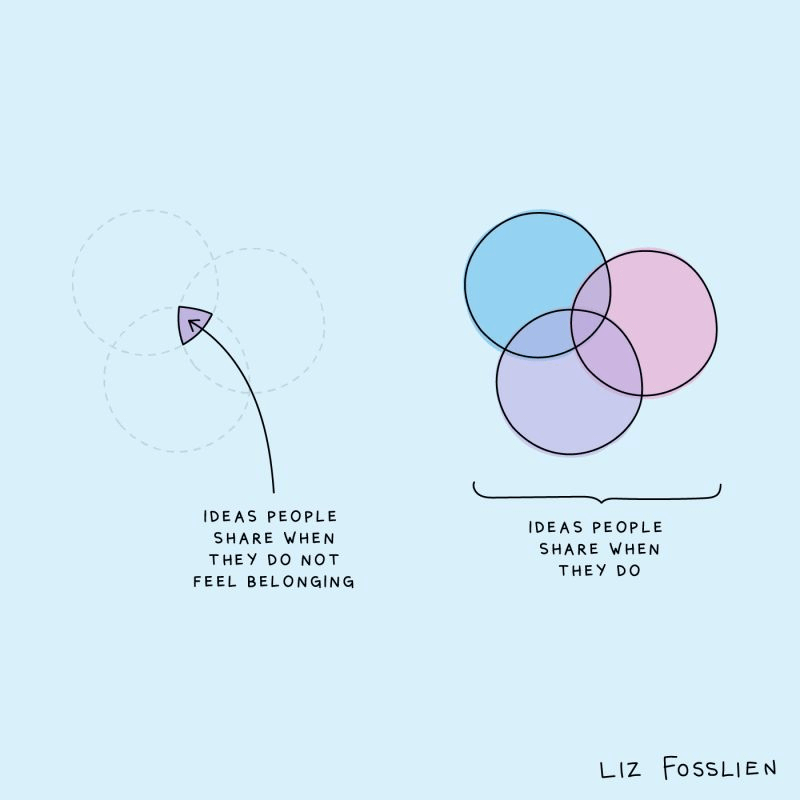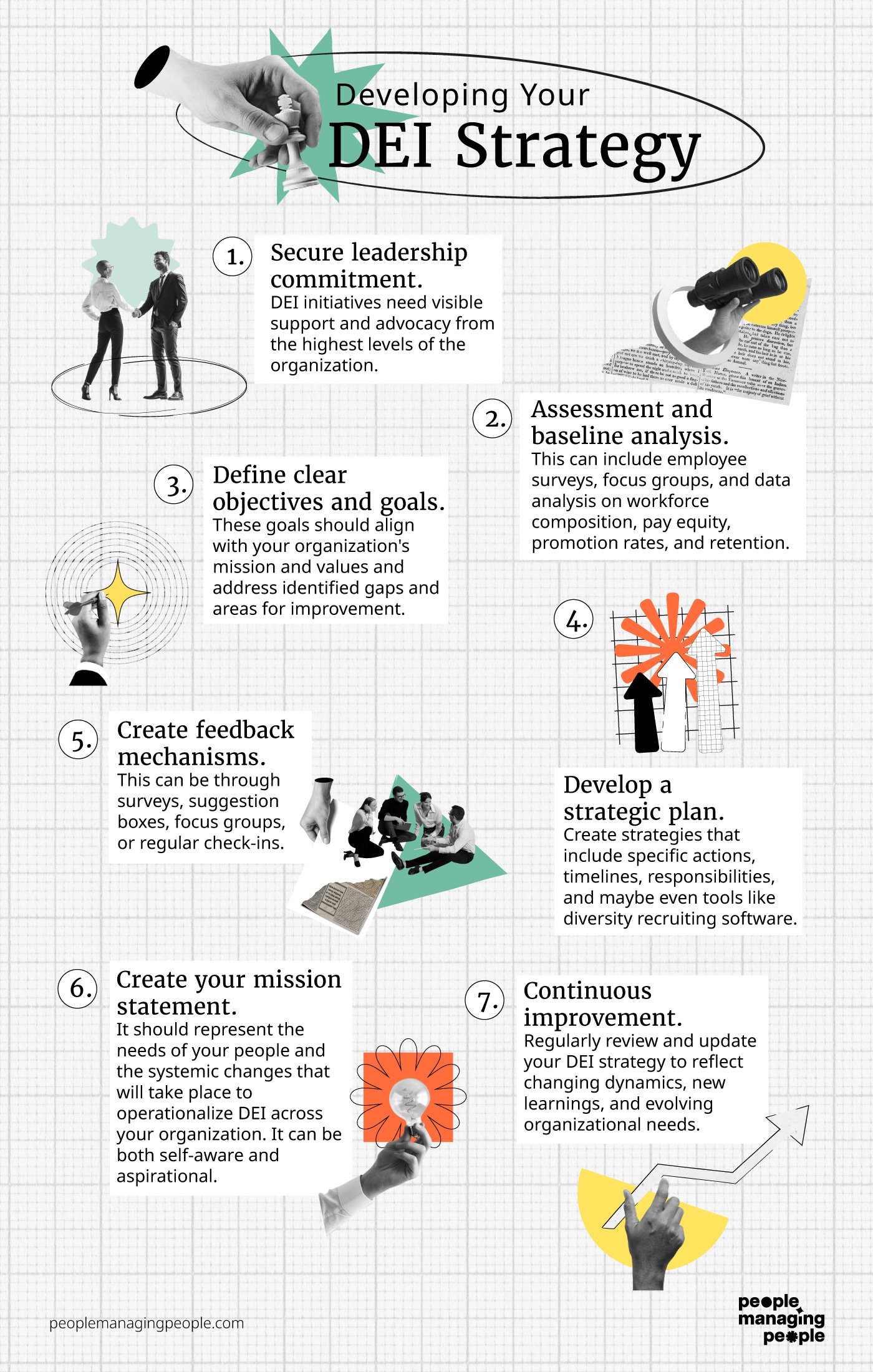As populations become increasingly diverse, the issue of diversity, equity, and inclusion (DEI) in the workplace is gaining importance.
We like to think that our workplaces are equitable and that everyone feels empowered and included, but (as we’ll go into) statistics indicate otherwise.
So, while we have come some distance in terms of welcoming women and underrepresented groups into the workplace, this endeavor is still far from over.
This article will give an overview of what DEI means in the workplace and point you in the direction of how you can formulate and work towards your DEI goals.
What Does DEI mean?
DEI stands for diversity, equity, and inclusion.
Diversity means all the ways that people are different, be it gender, gender identity, ethnicity, language, sexual orientation, disabilities, neurodiversity, socioeconomic status, age, religion, location, political perspective, or veteran status.
Equity stands for fairness and justice in the way that people are treated. This translates as impartiality and equal access when it comes to processes, programs, opportunities, and advancement. Removing inequities means everyone can reach their full potential. An example would be using pay equity solutions to ensure everyone is paid fairly for the job they do, without inherent bias.
Inclusion means that everyone has a sense of belonging in the workplace and that everyone feels like they can participate. Inclusive environments are those in which differences are embraced and supported and people feel like they can bring their true selves to work.
Why Are Diversity, Equity and Inclusion Important?
OK, besides the point that everyone’s human and we should treat each other with the same level of respect and kindness, numerous studies have shown the benefits of more diverse, equitable, and inclusive workplaces.
Benefits of diversity
- Increased productivity. A Boston Consulting Group study found that diverse workforces are 19% more productive.
- Increased innovation. A study published in Innovation: Management, Policy & Practice found that gender-diverse teams were more likely to introduce radical innovations into the market over a two-year period.
- More profitable. A McKinsey study found that diverse companies are 35% more likely to experience greater financial returns.
- Talent acquisition. From a hiring perspective, a Glassdoor survey found that 76% jobseekers consider a diverse work environment as an important factor when choosing a new company, and 32% would not apply to a job at a company where there is a lack of diversity in the workforce.
Benefits of inclusion
Of course, there’s no use having diverse teams, or any team at all for that matter, if all team members don’t feel included.
For example, a Culture Amp survey found that only 66% of women felt they could voice contrary views at work compared with 80% of men.
When people feel included and valued, they’re more likely to contribute their ideas.
This great illustration from Liz Fosslien sums it up perfectly.

Benefits of equity
The benefits of equity lie in talent development, employee engagement, and retention. But there are strong legal reasons also.
- Improved employee engagement and morale. When people are treated fairly and have equal opportunities, their engagement and morale improve. This leads to higher job satisfaction and motivation, positively impacting productivity.
- Attracting and retaining talent. People prefer to work in environments where fairness and equal opportunity are prioritized. A survey from Glassdoor found that 47% of black and 49% of Hispanic job seekers and employees have quit a job after witnessing or experiencing discrimination at work.
- Compliance with legal standards. An equitable workplace aligns with legal and regulatory standards, reducing the risk of legal issues related to discrimination and non-compliance.
How To Approach DEI Work
When we talk about DEI work, we refer to initiatives to address issues related to DEI and improving the workplace.
This could take the form of running more inclusive meetings, redesigning offices for people of all physical abilities, or implementing DEI training.
True DEI work means bringing about systemic change in our organizations, and this requires concerted effort. It’s why some organizations choose to appoint Chief Diversity Officers (CDOs) to implement and run DEI programs.
DEI metrics
Many organizations measure their DEI work using metrics such as representation and retention across different demographics.
For example, you could use data from your HRMS to figure out if people from minority groups are staying at the organization for a longer or shorter period relative to the average.
Examples of DEI metrics include:
- Diversity of applicants
- Diversity of workforce
- Retention across different groups
- Employee satisfaction
- Employee resource group participation.
However, while these high-level metrics are good indicators, as DEI expert Anthony Clay, rightly points out in our podcast 'Diversity is More Than a Metric':
“You can look at attrition as a data point. When did someone join? When did they leave? How long was that period relative to an average? But why do people leave? Maybe they lack career development opportunities because they don’t have mentors. And all of a sudden it becomes a conversation about career development.” - Anthony Clay.
DEI work is about peeling back the layers to understand our people and what’s happening in our organizations.
From there, you can invest resources into what DEI expert, Katie Zink, refers to in our podcast on building more diverse, equitable, and inclusive organizations as “winnable experiments” or practical DEI initiatives that you can measure and control.
This could be working toward more inclusive meetings, onboarding practices, or equitable feedback sessions and performance reviews.
Katie also recommends working with a DEI consultant or trained facilitator to help lead conversations around the employee experience that will be invaluable for directing DEI efforts.

Developing Your DEI Strategy
Secure leadership commitment
Secure commitment from top leadership. DEI initiatives need visible support and advocacy from the highest levels of the organization to ensure adequate resources and to signal the importance of these efforts.
Assessment and baseline analysis
Conduct a thorough assessment of the current state of diversity, equity, and inclusion in your organization.
This can include employee surveys, focus groups, and data analysis on workforce composition, pay equity, promotion rates, and retention.
You can also set up an automatic DEI dashboard in your HRMS to monitor these metrics on an ongoing basis, making tracking easier (among other HRMS benefits and functions.)
Define clear objectives and goals
Based on the assessment, define clear and measurable DEI goals.
These goals should align with your organization's mission and values and address identified gaps and areas for improvement.
Develop a strategic plan
Now you have your goals, you need to create strategies that include specific actions, timelines, responsibilities, and maybe even tools like diversity recruiting software.
For example, if a goal is to increase the diversity of your candidate pipeline, how are you going to do that?
This will fall under the recruitment departments’ remit, so they’d be the owners. A reasonable timeline might be three months, and a good start here might be to look at the wording of your job descriptions.
Create feedback mechanisms
Not all DEI goals are easy to measure by looking at quantitative data.
It’s beneficial to establish a system for continuous feedback on DEI initiatives such as your strategy for recruiting diverse candidates. This can be through surveys, suggestion boxes, focus groups, or regular check-ins.
Create your mission statement
A DEI statement is a written, formal articulation of the projected impact an organization strives to have toward increasing diversity, equity, and inclusion.
It should represent the needs of your people and the systemic changes that will take place to operationalize DEI across your organization. It can be both self-aware and aspirational.
But wait, shouldn’t this come first? Well, no.
Without first having some form of results from the initial efforts from your first round of goals, your mission statement won’t have the clout, relevance, or inspirational effect it needs.
Continuous improvement
Treat DEI as an ongoing journey rather than a destination. Regularly review and update your DEI strategy to reflect changing dynamics, new learnings, and evolving organizational needs. To help you continue learning we've built lists of some useful DEI newsletters to subscribe to and the best DEI courses that will help you along the way.

